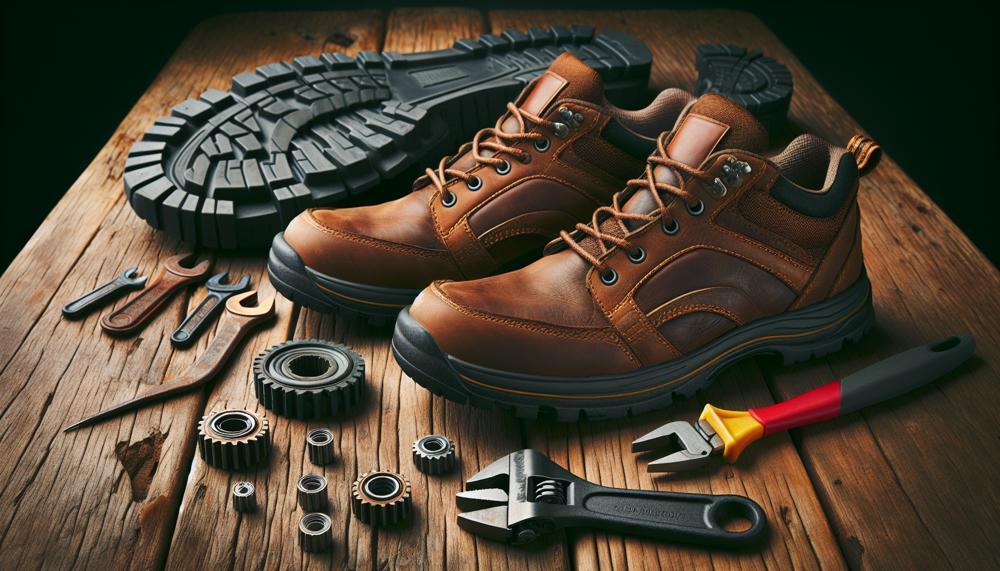Are your work shoes showing signs of wear and tear? Do they no longer provide the support and comfort they once did? It may be time to bid farewell to your trusty footwear and welcome a new pair into your work wardrobe.
While it’s easy to get attached to our favorite shoes, it’s important to remember that just like any other tool or equipment, work shoes have an expiration date.
Neglecting to replace them can lead to discomfort, injuries, and even decreased productivity.
So, let’s dive into the world of work shoe replacement and learn why staying on top of it is crucial for both safety and performance.
First things first, how often should you actually replace your work shoes? The general recommendation is every 6-12 months, depending on usage and wear. This may seem like a short lifespan for a pair of shoes, but think about all the hard work they do on a daily basis. From walking on different surfaces to supporting your body weight throughout the day, work shoes go through a lot. And just like anything else that gets used frequently, they will eventually wear out.
But why is it important not to wait too long before replacing them? Well, worn out work shoes can cause discomfort and even lead to injuries such as blisters or foot pain. This can greatly affect your job performance and make those long shifts feel even longer. Plus, old worn-out shoes are less effective at providing proper support and stability which increases the risk of slips or falls in hazardous working environments.
To extend the lifespan of your work shoes, proper care and maintenance are key. Regularly cleaning them and avoiding excessive exposure to water or extreme temperatures can help prolong their durability. However, investing in high-quality work shoes is also worth considering in the long run. They may cost more upfront but will save you money in the long term by lasting longer and providing better support.
Factors that Affect the Lifespan of Work Shoes
Contents [show]
The lifespan of work shoes can be influenced by several key factors, including frequency of use, environment, material and construction quality, and maintenance and care.
These factors can greatly impact how long your work shoes will last, but with proper management strategies, you can ensure maximum longevity for your footwear.
- One factor to consider is the frequency of use. If you use your work shoes more frequently, they will naturally wear out faster. To combat this, try rotating between at least two pairs of work shoes. This allows each pair to rest and recover between uses, ultimately prolonging their lifespan.
- The environment in which you wear your work shoes can also play a significant role in their longevity. Harsh elements and physically demanding jobs can cause wear and tear on your shoes. To protect them, it’s best to use your work shoes exclusively at work and consider purchasing specialized footwear for extreme environments.
- Material and construction quality are also important factors to consider when it comes to the lifespan of work shoes. Poor quality materials or construction can significantly decrease how long your shoes will last. It’s worth investing in high-quality work shoes with durable materials, such as leather or rubber. Regularly inspecting your shoes for signs of wear and tear and addressing any issues promptly can also help prolong their lifespan.
- Lastly, maintenance and care are essential for keeping your work shoes in good condition for as long as possible. Neglecting maintenance or proper care can lead to deterioration and decrease their lifespan. Make sure to regularly clean, condition, and store your work shoes properly. If needed, consider replacing worn-out insoles or fixing stitches, but keep in mind that these are only temporary solutions.
Recommendations for Replacement
When it comes to replacing your work shoes, there are several key factors that you should take into consideration. These include the type of material used, how often and how intensely you use your shoes, any industry guidelines or regulations, wear and tear, functional performance, and personal hygiene and appearance.
- First and foremost, the material of your work shoes can greatly impact their durability and longevity. For example, if you invest in high-quality leather shoes, they are more likely to withstand heavy use compared to synthetic materials that may wear out more quickly.
- The frequency and intensity of use can also play a role in how often you’ll need to replace your work shoes. Those with physically demanding jobs or working in more demanding environments may need to replace their shoes more frequently than those with less strenuous jobs.
- In addition, different industries or companies may have specific guidelines or regulations regarding the replacement of work shoes. It’s important to follow these guidelines to ensure compliance and safety in the workplace.
- Regularly inspecting your work shoes for signs of wear and tear is crucial in determining when it’s time for a replacement. Look out for worn soles, damaged laces, or holes as these can all indicate the need for new shoes.
- Furthermore, it’s important to consider the functional performance of your work shoes. If they are no longer performing their intended function or pose a risk to the wearer, they should be replaced immediately. This is especially important in industries where safety is a top priority.
- Lastly, personal hygiene and appearance should not be overlooked when determining when to replace your work shoes. Stained or ill-fitting shoes can impact hygiene and appearance, while strong odors may indicate an immediate need for replacement.
Signs You Need a New Pair of Work Shoes
| 1. | Worn out soles: | If the soles of your work shoes are visibly worn out, it’s time to consider getting a new pair. The tread on the soles provides traction and stability, and once it’s worn down, it can increase the risk of slipping or falling. You don’t want to be the one who falls flat on their face in front of their boss, do you? Trust me, I’ve been there. |
| 2. | Torn or damaged upper material: | Inspect the upper material of your work shoes for any tears, holes, or other damage. This can compromise the integrity of the shoe and lead to discomfort or even injury. I learned this the hard way when I kept wearing my torn work shoes and ended up with blisters all over my feet. |
| 3. | Lack of support or cushioning: | If your work shoes no longer provide adequate support or cushioning for your feet, it’s time for a new pair. This can lead to foot pain and discomfort, which can affect your overall productivity at work. Trust me, I’ve been there too. My feet were killing me after every shift because I didn’t realize my shoes had lost their support. |
| 4. | Worn out insoles: | The insoles of your work shoes play a crucial role in providing support and cushioning for your feet. If they are visibly worn out or flattened, it’s time to replace them. You don’t want to be walking on thin insoles all day long. It’s not good for your feet or your job performance. |
| 5. | Foot discomfort or pain: | If you are experiencing foot pain or discomfort while wearing your work shoes, it could be a sign that they need to be replaced. This is especially important if you have already checked for visible signs of wear and tear on the shoes. Don’t wait until your feet are screaming in agony to realize that your shoes are the problem. |
Remember, replacing work shoes regularly is crucial for safety and comfort.
It’s recommended to replace them every 6 to 12 months, but this may vary based on individual circumstances.
Regularly inspect your work shoes for signs of wear and tear, and if you notice any of the above signs, it’s time to invest in a new pair.
4 Ways To Make Your Boots Last Longer
It’s no secret that keeping your work shoes in good condition can be a costly endeavor.
However, with proper maintenance and storage, regular inspections, and implementing rotation and investing in quality products, you can significantly extend the lifespan of your shoes and save money in the long run.
Let’s dive into four key ways you can make your boots last longer.

| Proper Maintenance | – Be sure to regularly clean your shoes with a gentle brush or cloth to remove any dirt and debris. This helps prevent buildup that can lead to material deterioration. | |
| – For leather materials, use a conditioner or oil to keep them soft and prevent cracking. | ||
| – Consider using waterproof spray on materials that are prone to water damage. | ||
| Regular Inspections | – Take the time to inspect your shoes for any signs of wear and tear, such as flattened midsoles, excessive creasing, or fraying stitches. | |
| – Pay attention to any new discomfort or pain while wearing your shoes as this could be a sign that they need to be replaced. | ||
| Rotation is Key | – Having at least two pairs of work shoes in rotation allows each pair to rest and recover between uses, significantly extending their lifespan. | |
| Invest in Quality Products | – It’s worth investing in high-quality shoes as they tend to last longer and can withstand more wear and tear. | |
| – Consider using LoopKing laces, made with premium materials that can help prolong the life of your shoes. |
By following these simple yet effective ways to extend the lifespan of your work shoes, you can save money in the long run by avoiding frequent replacements.
It’s also crucial to consider the type of job and usage frequency when determining when to replace your work shoes, as these factors can significantly affect their lifespan.
Conclusion
In conclusion, maintaining the condition of your work shoes is vital for both safety and performance. While it may be tempting to hold onto your trusty pair, neglecting to replace them can lead to discomfort, injuries, and decreased productivity.
The recommended replacement frequency is every 6-12 months, depending on usage and wear.
However, other factors such as material quality and maintenance also play a significant role in the lifespan of work shoes.
Regularly inspecting your shoes for signs of wear and tear and following guidelines for different types of jobs can help you make informed decisions about replacement. Signs that it’s time for a new pair include worn out soles, torn or damaged upper material, lack of support or cushioning, worn out insoles, and foot discomfort or pain.
To prolong the longevity of your work shoes, proper maintenance and care are crucial. Regularly cleaning them and avoiding harsh environments can help extend their durability. Additionally, investing in high-quality work shoes is worth considering as they tend to last longer and provide better support.
By implementing rotation strategies and investing in quality products like LoopKing laces, you can significantly extend the lifespan of your work shoes while saving money in the long run. Remember – replacing work shoes regularly is essential for safety and comfort. Don’t wait until it’s too late.






